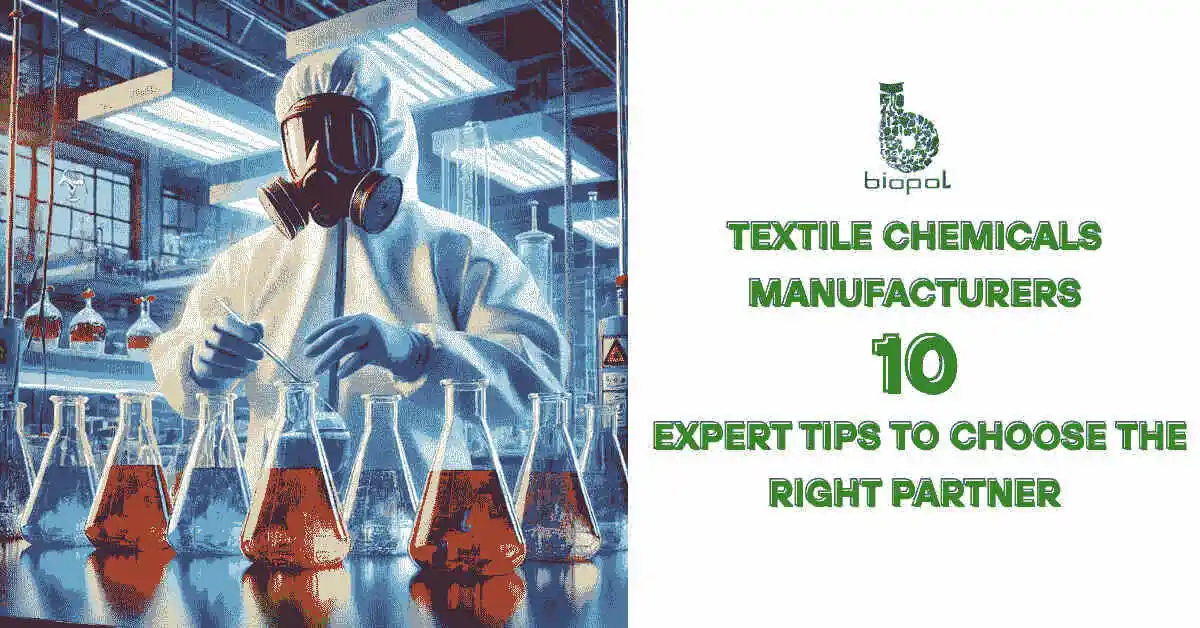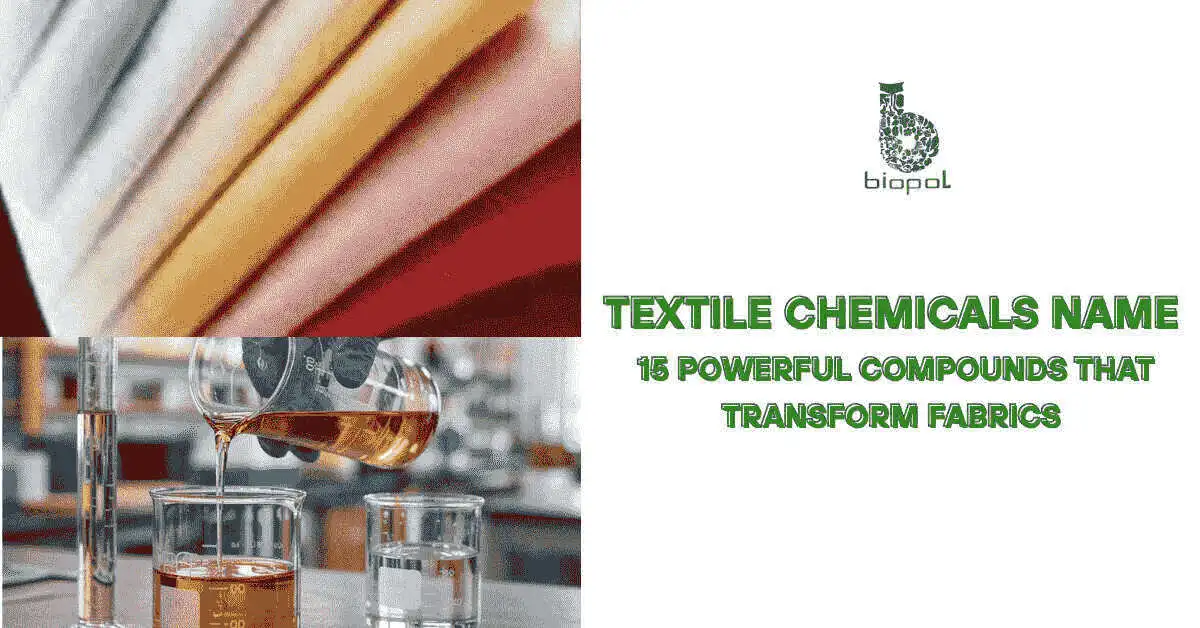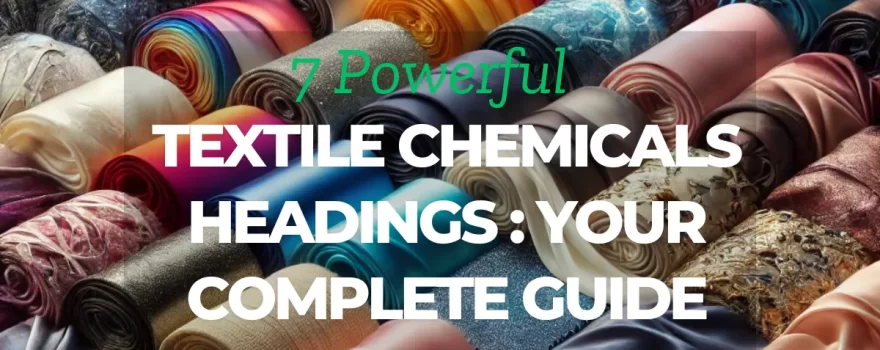
Textile Chemicals Headings refers to the primary categories of textile chemicals based on their function. These categories constitute essential components within contemporary fabric manufacturing. These substances facilitate the transformation of raw fibers into finished textile products. Their function encompasses pre-treatment, coloration, printing, and finishing processes, each reliant upon specific chemical interactions.
Table of Contents
Textile Chemicals Headings
The demand for Textiles chemicals headings or textile chemicals’ main categories stems from their ability to improve the performance, visual appeal, and longevity of fabrics. Without their application, the attainment of vibrant hues or water-resistant properties would prove unattainable.
The application of these chemicals adheres to scientific principles, wherein each compound serves a distinct purpose. Precision in application is paramount to achieving desired outcomes. The textile sector depends on these materials to produce goods that meet the necessary quality standards. An examination of this critical domain follows.
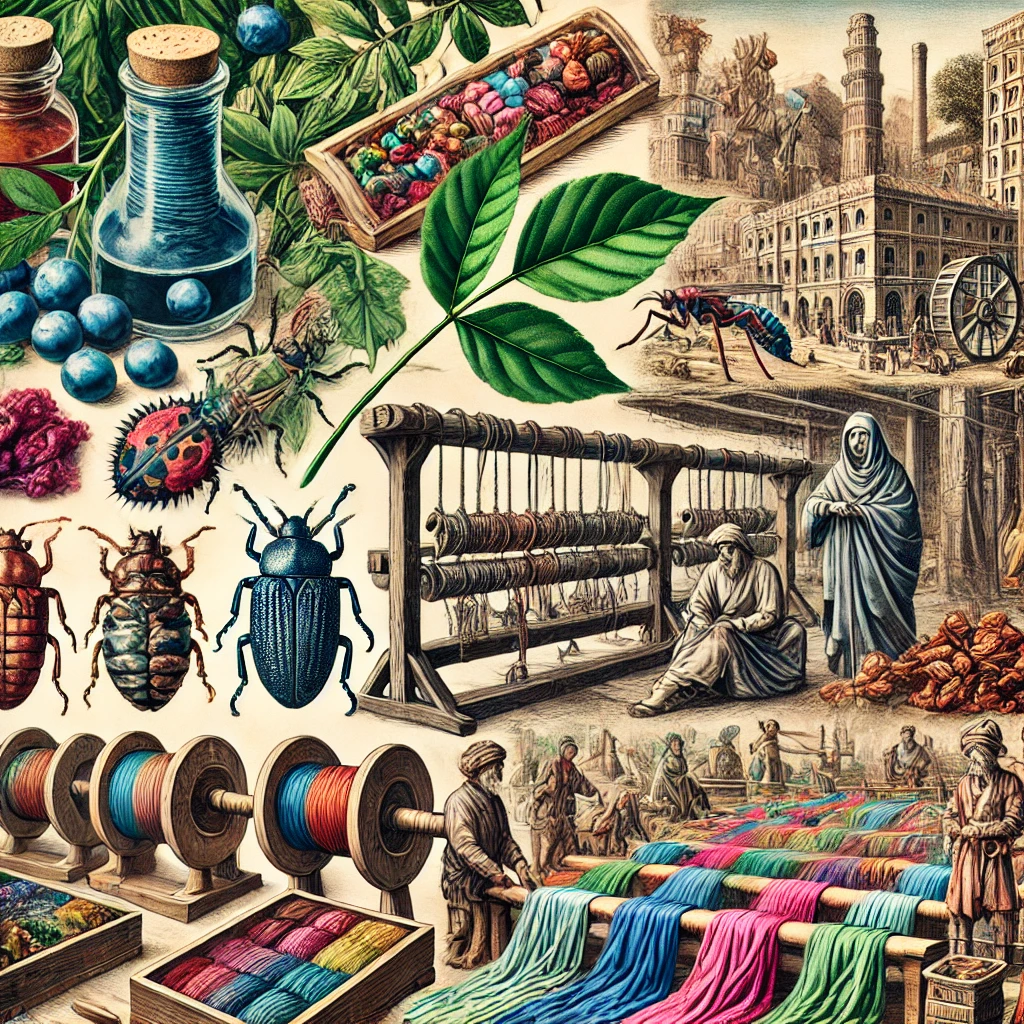
History of Textile Chemicals Headings
Its journey begins at natural extracts and continues to synthetic marvels. Early textiles relied on natural dyes. Think berries, roots, and insects. These provided color, but lacked consistency. Fast forward, and the Industrial Revolution birthed synthetic dyes. Suddenly, vibrant, repeatable colors became accessible. This marked a major shift. We moved from nature’s limited palette to chemical innovation.
The 20th century saw another leap. Functional finishes became the norm. Flame retardants, water repellents, and wrinkle-resistant treatments transformed fabric performance. The focus had shifted from mere aesthetics to functionality. Are you thinking about the environmental impact? Yes, that’s a concern. Contemporary studies emphasize the importance of sustainable alternatives. We are engaged in the development of bio-based chemicals and processes aimed at minimizing waste. The evolution continues, balancing performance with ecological responsibility.
Textile Chemicals Headings: Types & Applications
Chemicals play specific roles at various stages of the textile manufacturing process. Here’s a look at some key categories:
Pre-treatment Chemicals
- These prepare fabrics for subsequent processes.
- Examples include:
- Scouring agents: To remove impurities like oils and waxes.
- Bleaching agents: To whiten fabrics.
- Mercerizing agents: Used to enhance luster and strength, particularly in cotton.
Dyeing Chemicals
- These impart color to textiles.
- This category includes:
- Dyes (reactive, disperse, acid, etc.): Each suited to specific fiber types.
- Auxiliary chemicals: Such as leveling agents, to ensure even color distribution.
Printing Chemicals
- Used to create patterns and designs on fabrics.
- These include:
- Thickeners: To control the viscosity of printing pastes.
- Binders: To fix pigments on the fabric.
Finishing Chemicals
- These enhance the performance and aesthetic properties of textiles.
- Examples:
- Softeners: To improve fabric feel.
- Water repellents: To make fabrics water-resistant.
- Flame retardants: To reduce flammability.
- Wrinkle resistant chemicals: to reduce wrinkling.
Auxiliary Chemicals
- These chemicals support the other processes.
- Surfactants, leveling agents, and dispersing agents.
It’s important to note that the selection of chemicals depends heavily on the type of fiber being processed (natural or synthetic) and the desired end product.
Pre-Treatment Chemicals
It sets the stage for everything that follows. Think of it as prepping a canvas before painting. You wouldn’t paint on a dirty, rough surface, right? The same applies to textiles. These chemicals clean, smooth, and prepare fabrics for dyeing and finishing. Without them, the end result would be subpar.
Here’s a breakdown of the key pre-treatment processes:
- Desizing:
- This removes sizing agents, like starch, that are added to yarns for weaving.
- It ensures dyes and finishes can penetrate the fabric evenly.
- Enzymes and acids are often used.
- Scouring:
- This cleans the fabric by removing natural impurities like oils, waxes, and dirt.
- It uses alkaline solutions and surfactants.
- It’s essential for achieving a clean, absorbent fabric.
- Bleaching:
- This whitens the fabric by removing natural color pigments.
- Hydrogen peroxide and sodium hypochlorite are common bleaching agents.
- It provides a uniform base for dyeing.
- Mercerizing:
- This process is specific to cotton.
- It involves treating the fabric with a strong alkali, like sodium hydroxide.
- It increases luster, strength, and dye uptake.
These pre-treatment steps are vital. They ensure that fabrics can be dyed and finished effectively. They are the foundation of quality textile production.
Printing Chemicals
It brings patterns to life. It’s the art of transferring color onto fabric. But it’s not just about slapping some dye on. It requires precision and the right chemicals. Think of printing chemicals as the artist’s palette, each one playing a crucial role.
Here’s a look at the key components:
- Thickeners:
- These control the viscosity of the printing paste.
- They prevent the paste from spreading, ensuring sharp edges.
- Examples include starches, gums, and synthetic polymers.
- Binders:
- These fix the pigments or dyes to the fabric.
- They create a durable bond that withstands washing and wear.
- Acrylics and polyurethanes are commonly used.
- Dispersing Agents:
- These ensure pigments are evenly distributed in the printing paste.
- They prevent clumping and ensure uniform color application.
- They are very important for pigment printing.
- Fixing Agents:
- These enhance the fastness of the print.
- They improve resistance to washing, rubbing, and light.
- These are used after the printing process.
- Reducing Agents:
- These are used in discharge printing.
- These remove color from previously dyed fabric, to create a design.
- Catalysts:
- These speed up the reaction between the binder and the fabric.
- They are used to improve the efficiency of the printing process.
Without these chemicals, printed textiles would be a blurry mess. They’re the secret behind the crisp lines and vivid colors we see. They are the difference between an amateur print and a professional one.
Dyeing Chemicals
It represents a critical facet of textile processing. These substances, distinct from the dyes themselves, serve to optimize the efficacy of color application. Their significance resides in their capacity to augment color uptake, uniformity, and fastness. Without the application of appropriate auxiliaries, the attainment of consistent and enduring coloration proves challenging.
The function of these auxiliaries can be delineated as follows:
- Leveling Agents:
- To prevent uneven coloration, leveling agents ensure a uniform distribution of dyes by modulating dye uptake.
- Dispersing Agents:
- These are particularly pertinent in the processing of synthetic fibers.
- They function to disaggregate dye particles, maintaining their suspension within the dye bath.
- They prevent agglomeration of dye particles.
- Retarding Agents:
- These agents control the speed of the dyeing process.
- They are especially useful in high temperature dyeing.
- Fixing Agents:
- These agents enhance color fastness, promoting the permanent bonding of dyes to the fabric substrate.
- They serve to prevent color degradation during laundering.
- Sequestering Agents:
- These agents remove metallic ions from the aqueous medium, which may impede the dyeing process.
- They assure uniformity of color.
In summation, dyeing auxiliaries are instrumental in the achievement of vibrant and durable coloration, transforming the dyeing process into a controlled and precise operation.
Finishing Agents
These are integral to the production of textiles with augmented functional properties. These chemical entities impart specific characteristics that extend beyond mere aesthetic considerations. Performance attributes, such as water resistance and flame retardancy, are achieved through the application of these agents.
The following categories delineate the principal types of finishing agents and their respective applications:
- Water Repellents:
- These agents establish a barrier against moisture penetration, thereby preventing liquid absorption.
- Applications include outerwear and upholstery.
- Flame Retardants:
- These agents diminish the flammability of textile materials, enhancing safety.
- Applications are prevalent in domestic and public environments.
- Softeners:
- These agents ameliorate the tactile properties of textiles, rendering them smoother and more comfortable.
- Applications encompass apparel and bedding.
- Wrinkle-Resistant Finishes:
- These agents mitigate the formation of creases, simplifying textile maintenance.
- Applications are advantageous for travel apparel and everyday wear.
- Antimicrobial Finishes:
- These agents impede the proliferation of microorganisms, curtailing odor generation and prolonging textile longevity.
- Applications are utilized in sportswear and medical textiles.
- UV Protection Finishes:
- These agents protect the fabric, and the skin beneath the fabric, from harmful UV radiation.
- Applications are utilized in outdoor clothing.
These agents are fundamental to the production of textiles that meet stringent performance criteria. They convert basic fabrics into products that fulfill specialized requirements.
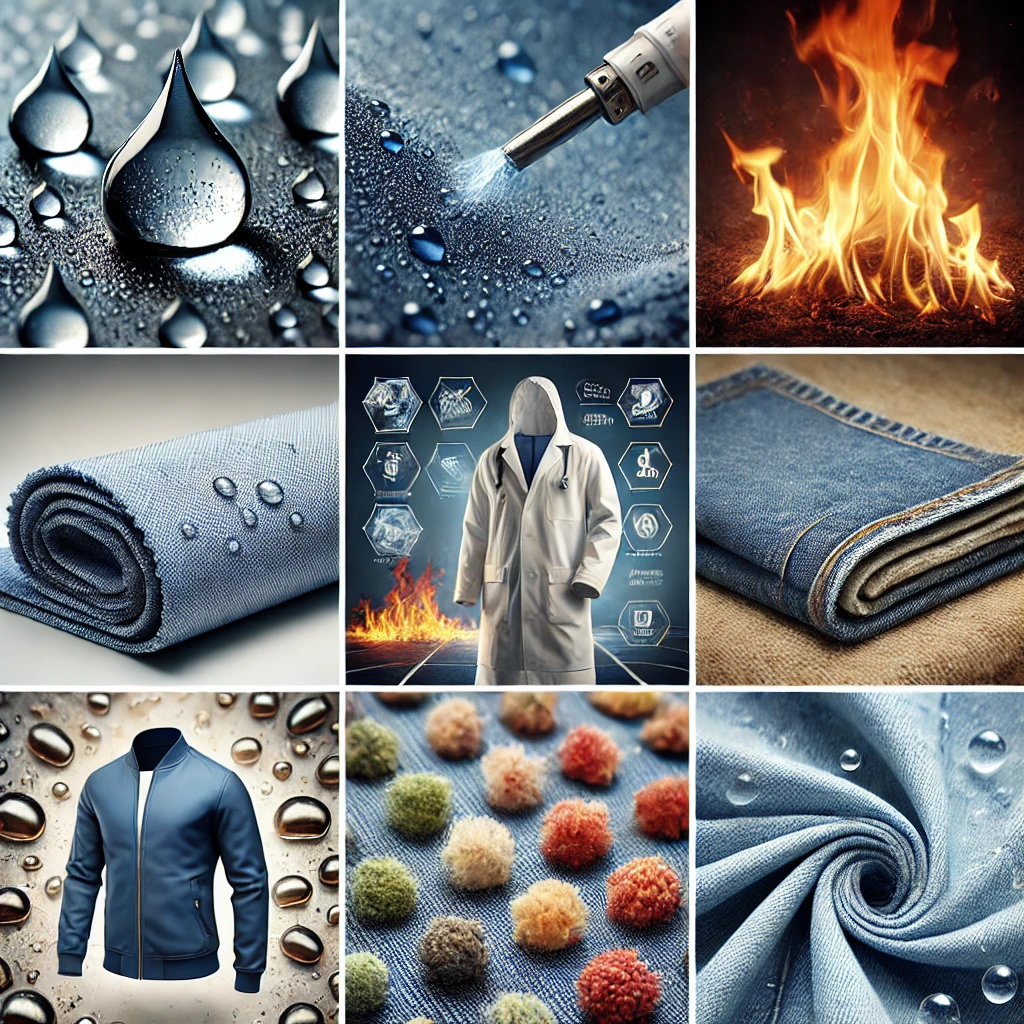
Enzymes in Textile Processing: Sustainable Alternatives
It represents a shift towards greener practices. Forget harsh chemicals. Enzymes are nature’s catalysts. They’re proteins that speed up reactions, and they’re changing the game in textile production. Why? They’re biodegradable and work under milder conditions. That means less waste and lower energy consumption.
Here’s how enzymes are making a difference:
- Bio-Scouring:
- Instead of harsh alkalis, enzymes remove impurities like pectins and waxes.
- This reduces water and energy usage.
- It’s gentler on the fibers, too.
- Bio-Polishing:
- Cellulase enzymes smooth the surface of cotton fabrics.
- This reduces pilling and gives a smoother finish.
- It replaces harsh mechanical treatments.
- Bio-Desizing:
- Amylase enzymes break down starch-sizing agents.
- This is more efficient and environmentally friendly than traditional methods.
- It reduces chemical waste.
- Bio-Bleaching:
- Certain enzymes can assist in bleaching processes, reducing the need for harsh chemicals like hypochlorite.
- Enzyme-aided dyeing:
- Some enzymes can enhance the uptake of dye, which reduces the amount of dye, and auxiliary chemicals, needed.
The use of enzymes aligns with the growing demand for sustainable textiles. They offer a cleaner, more efficient way to process fabrics. It’s a win for the environment and for textile quality.
Eco-Friendly Textile Chemicals: Sustainable Production
It is not just a trend; it’s a necessity. We’ve seen the impact of traditional textile processing. It’s time for a change. The goal? To minimize environmental footprint while maintaining quality. We need chemicals that are safer for people and the planet.
How are we achieving this?
- Bio-based Chemicals:
- These are derived from renewable resources like plants and microorganisms.
- They replace petroleum-based chemicals, reducing reliance on fossil fuels.
- Examples include enzymes, bio-polymers, and natural dyes.
- Reduced Chemical Usage:
- Technologies that minimize the amount of chemicals required.
- Examples include high-efficiency dyeing and printing techniques.
- This also reduces the amount of water needed.
- Safer Chemical Alternatives:
- Replacing hazardous chemicals with less toxic options.
- This protects workers and reduces pollution.
- Focus on chemicals with lower toxicity and higher biodegradability.
- Closed-Loop Systems:
- Recycling and reusing chemicals and water.
- This minimizes waste and reduces environmental impact.
- This type of system is very important for water conservation.
- Certifications and Standards:
- Adhering to eco-labels like OEKO-TEX and GOTS.
- These ensure products meet strict environmental and social criteria.
- This gives the consumer confidence in the product.
The move towards eco-friendly textile chemicals is about more than just being “green.” It’s about responsible production. It’s about creating a sustainable future for the textile industry.
Impact of Textile Chemicals on the Environment
Impact of Textile Chemicals on the Environment is a serious concern. The textile industry, while vital, has a significant environmental footprint. Traditional chemicals and processes can lead to pollution and resource depletion. We can’t ignore the consequences.
Here’s a look at the key environmental impacts:
- Water Pollution:
- Dyes and chemicals discharged into waterways can harm aquatic life.
- Heavy metals and toxic substances can contaminate drinking water.
- This is a major issue in textile-producing regions.
- Air Pollution:
- Volatile organic compounds (VOCs) released during processing contribute to air pollution.
- Emissions from chemical manufacturing and textile factories can be harmful.
- This impact can affect the health of nearby communities.
- Soil Contamination:
- Improper disposal of textile waste can lead to soil contamination.
- Chemicals can leach into the soil, affecting plant growth and groundwater.
- This is especially true with certain heavy metal containing dyes.
- Resource Depletion:
- Traditional textile processing consumes large amounts of water and energy.
- The use of non-renewable resources contributes to environmental degradation.
- The use of cotton, a very thirsty crop, only adds to the problem.
- Chemical Accumulation:
- Some textile chemicals can accumulate in the environment and in living organisms.
- This can lead to long-term health and ecological problems.
- This is a serious concern with some of the older flame retardant chemicals.
We must shift towards more sustainable practices. The environmental cost of textiles is too high. It’s imperative that the textile industry take responsibility for the impact that it has.
Compliance and Regulations in Textile Chemical Usage
These are vital for safety and sustainability. This isn’t just about following rules. It’s about protecting people and the environment. The textile industry faces scrutiny. It must adhere to strict standards.
Here’s a breakdown of key aspects:
- REACH (Registration, Evaluation, Authorization and Restriction of Chemicals):
- This EU regulation controls the use of chemicals.
- It aims to protect human health and the environment.
- It requires companies to register and assess the safety of chemicals.
- OEKO-TEX Standard 100:
- This certification tests textiles for harmful substances.
- It ensures products are safe for consumers.
- It provides confidence in product safety.
- ZDHC (Zero Discharge of Hazardous Chemicals):
- This initiative aims to eliminate hazardous chemicals from the textile supply chain.
- It promotes sustainable chemical management.
- It provides a MRSL (Manufacturing Restricted Substance List) that companies can use to avoid hazardous chemicals.
- Local and National Regulations:
- Countries and regions have their own regulations on chemical usage.
- These regulations vary, requiring companies to stay informed.
- These regulations often focus on waste water treatment, and air emissions.
- Worker Safety:
- Regulations protect workers from exposure to hazardous chemicals.
- This includes proper handling, storage, and disposal of chemicals.
- This is a large part of OSHA regulations in the United States.
- Environmental Protection Agencies (EPAs):
- These agencies enforce environmental regulations.
- They monitor and regulate chemical discharges and emissions.
- They provide guidelines for best management practices.
Adhering to these regulations is not optional. It’s a responsibility. It’s about ensuring a safe and sustainable textile industry.
Future Trends in Textile Chemicals Industry
This points towards innovation and sustainability. The textile world is changing. We’re moving beyond traditional methods. Expect to see a focus on eco-friendly solutions and advanced technologies.
Here’s what the future holds:
- Biotechnology and Bio-based Chemicals:
- Increased use of enzymes and microbial processes.
- Development of new bio-polymers and natural dyes.
- This aligns with the growing demand for sustainable products.
- Nanotechnology:
- Use of nanoparticles to enhance textile properties.
- Improved durability, water resistance, and antimicrobial properties.
- Smart textiles with embedded sensors and functionalities.
- Digital Printing and Customization:
- Advanced digital printing techniques for precise and sustainable designs.
- On-demand production and customization to reduce waste.
- This allows for a more flexible and responsive supply chain.
- Closed-Loop Chemical Management:
- Implementation of systems to recycle and reuse chemicals.
- Minimization of waste and pollution.
- This is vital for resource conservation.
- Advanced Finishing Technologies:
- Development of finishes that provide multiple functionalities.
- Self-cleaning, self-repairing, and enhanced comfort properties.
- Plasma treatments, and other low impact finishing technologies.
- Increased Transparency and Traceability:
- Use of blockchain and other technologies to track chemical usage.
- Ensuring ethical and sustainable sourcing.
- This will provide greater accountability.
The future of textile chemicals is about innovation and responsibility. It’s about creating products that are both high-performing and environmentally friendly. It is an exciting time for the industry.
Conclusion
The journey of textile chemicals headings reflects a constant evolution. We’ve moved from basic natural substances to complex synthetic compounds. Now, the focus is on sustainability and innovation. The road ahead demands a shift. We must embrace eco-friendly alternatives and advanced technologies.
The industry faces challenges. Environmental impact and regulatory pressures are significant. Yet, these challenges present opportunities. Opportunities for innovation, for developing safer chemicals, and for adopting cleaner production methods.
The future lies in responsible chemical management. We need transparency and traceability throughout the supply chain. We must prioritize worker safety and environmental protection. Certifications and standards play a crucial role. They provide assurance and drive improvement.
The textile chemicals industry is at a turning point. We can choose a path of sustainable growth. A path that balances performance with ecological responsibility. By embracing innovation and prioritizing sustainability, we can create a brighter future for textiles.
Alos Read: Textile Chemicals: The Secret Sauce Behind Your Clothes
